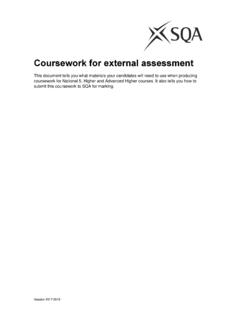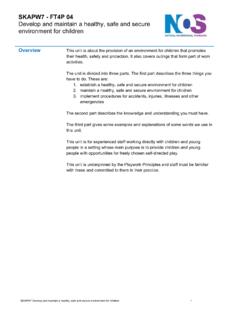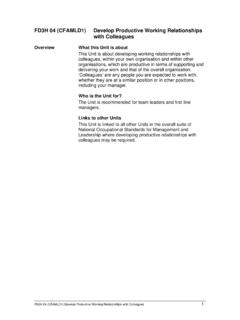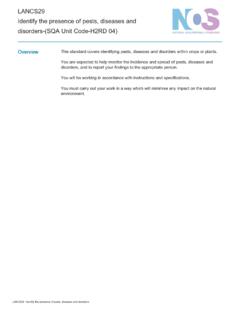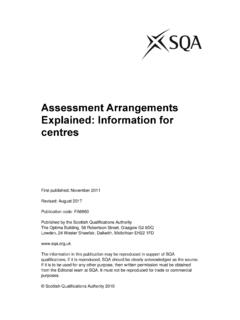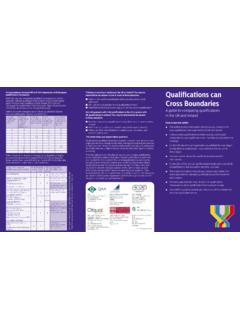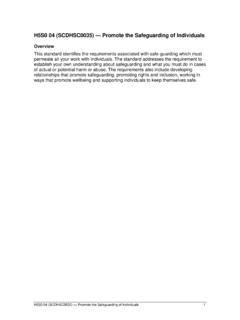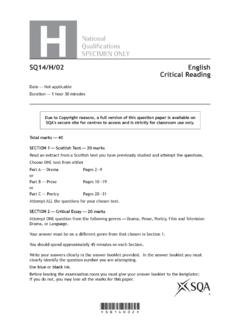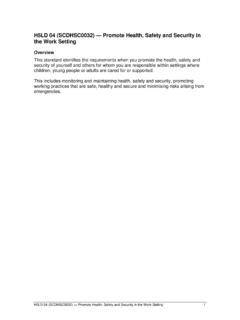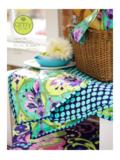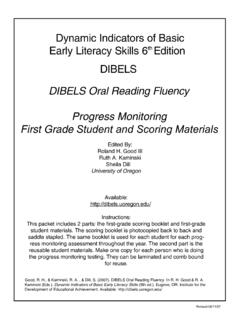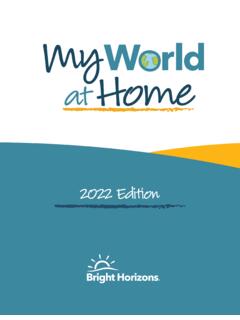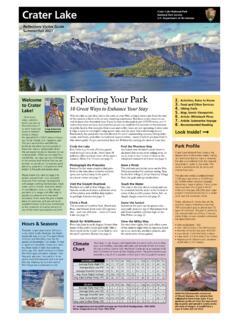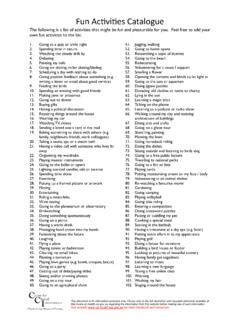Transcription of National 4XDOLÛFDWLRQV 2019 - SQA
1 *X8247511*N5 NationalQuali cations2019 Total marks 30 Attempt ALL your answers clearly in the answer booklet provided. In the answer booklet you must clearly identify the question number you are blue or black leaving the examination room you must give your answer booklet to the Invigilator; if you do not, you may lose all the marks for this for Understanding, Analysis and EvaluationTHURSDAY, 9 MAY9:00 AM 10:00 AMA/SApage 02 How we eatIt is over thirty years since McDonald s opened its first UK drive-thru 1986 being a year of firsts for a brand that now has 1,200 restaurants across Britain. The figures show today s consumers really are lovin it , yet the fast food experience is also ubiquitous familiar, disposable and repeatable. So, how was it for customers when such places were still new? Was what is now commonplace ever thought a thrill?It is 1975. UK cinemas are showing an advert for a brand whose name, at this point, is principally linked in the National consciousness to a nursery rhyme farmer.
2 To the viewer, golden arches means nothing. A Big Mac is just an oversized advert comes a year after American fast food restaurants started to appear in London. Few Brits, however, have visited them. People are still using knives and forks. The past, as they say, is a foreign country they do things differently forward to 1983 and there are still only 100 McDonald s restaurants in the UK. The odds remain against most people seeing one. They literally do not know what they are 1986 rolls around and three things happen to boost our acquaintance with fast food empires. In Middlesex, the first franchises are given out by McDonald s to allow individuals to run their own stores. Another introduction is the Happy Meal, the very title of which suggests things have moved on from buying food to buying emotions eat this to feel like this. Things are now about experience. The stand-out concept in late-86, though, is the drive-thru: the missing o , g and h letting Brits know things are different.
3 Or at least in Manchester, where the first one opened, followed before the end of the year by drive-thrus in London and the West Midlands. It seemed a wacky idea and one with technology my family didn t trust. This is the memory of a present-day McDonald s customer Chris Hammond a West Midlands man born in the 70s and raised in the 80s. These were halcyon days for those who remember the brand when it was new and Britain was a thinner and, some would say, healthier nation. Chris gives an estimate of mid-80s for his first McDonald s visit, but it was not until as a teen in the 90s that he used a space age drive-thru, with its electronic ordering of goods via disembodied dialogue, overseen by teens in caps. The futuristic nature of it meant that we didn t understand what was meant to happen, he says. And friends who did use drive-thrus back then didn t quite know their purpose; their parents ordered the food but ate it in the car park.
4 It was driving through for its own sake. Now my car has a cup-holder as standard. But what was it that put on the brakes and left people confused as to whether to take home the food? How could things have ever appeared other and not for me ? In the mid-1980s a visit to a fast food eatery was so outwith the realm of everyday experience that it created doubt over how to be and how to feel uncertainty mixed with a thrill now difficult to imagine. This was a place where up was down and even falsehood had an air of glamour. McDonald s was the first place I ever saw a fake plant, one early customer new environment scrambled people s brains. Before the arrival of fast food establishments, children s experience of eating out was limited. Social eating tended to happen at home, or at school, or at a friend s house. Yet here was a restaurant where they did not have to keep their legs still. It was a picnic inside.
5 Christmas in thought the once-a-year visit to McDonald s exotic , the Filet-O-Fish posh , and the taste secondary to going at all. Chris remembers it as an event . It was an experience and destination unto itself. And one which created a cultural shift towards American eating habits. At first, he said, recalling colourful, plastic toadstools for seats, McDonald s seemed to be only about children s parties I couldn t conceive of people just going for something to eat, but after a while, I was one of 03 Before, I had been used to knives and forks, but here you were out of the house and using your hands without a plate. And yet my parents felt the need to formalise it all by choosing what amounted to a starter, a main course and a pudding. But the balance of formality and convenience in the 80s played havoc with concepts of time. Fast food? It was not that simple. We were never sure, Chris said, about how quickly to get away. If anything, it was the opposite of fast food and we hung around.
6 You wanted it to feel like it was a thing you d set out to do. The product the nostalgic are most excited to recall is the Big Mac, which was invented in 1967 by a US franchisee, and is still going, of course. But it is now a background thing, rarely resulting in a second glance, except at the discarded gherkins: discs of crinkly pickled cucumber left on a table top. But thirty or more years ago, the Big Mac drew kids gasps. In one sesame-seeded stack it seemed to rip up the rulebook. With its two burgers and bread bridge, the top half mirrored the bottom; a sort of bun and beef palindrome for mouths that crucially were milk teeth-free. I thought Big Macs were only for truckers and wrestlers, Chris said. I thought there must be a rule about it. It was typical of those early fast food experiences: confusion, newness and thrill all at once. It sounds like love. Or at least lovin it. But lovin it now in a different century, where eating habits have certainly changed, has brought with it another cultural shift a growing awareness of how and what we from an article by John Newton on the BBC news 04 MARKST otal marks 30 Attempt ALL questions 1.
7 Look at lines 1 referring to two examples of word choice, explain how the writer gives a clear impression of the fast food experience. 2. Look at lines 6 referring to one example of language, explain how the writer makes it clear that McDonald s was unfamiliar when it first came to the UK. 3. Look at lines 12 , using your own words as far as possible, how McDonald s developed in Britain in the should make four key points in your answer. 4. Look at lines 21 referring to two examples of language, explain how the writer makes it clear that a visit to McDonald s could have seemed strange. 5. By referring to any part of the sentence in line 28 ( The futuristic nature .. , he says ), explain how it helps to provide a link between the writer s ideas at this point in the passage. 6. Look at lines 32 your own words as far as possible, identify six ways in which fast food affected people s eating habits. 7. Look at lines 51 your own words as far as possible, explain what the writer means when he describes the 80s as a time of formality and convenience.
8 8. Look at lines 55 referring to two examples of language, explain how the writer makes it clear that there have been different reactions to the Big Mac over time. 9. Look at line 63 any expression from these lines and explain how it contributes to the passage s effective conclusion.[END OF QUESTION PAPER]424426242page 05 OPEN OUT FOR QUESTIONSDO NOT WRITE ON THIS PAGE page 06[BLANK PAGE]DO NOT WRITE ON THIS PAGEA cknowledgement of copyrightArticle Article is adapted from The McDonalds drive-thru at 30: A journey back to an exotic experience by John Newton, from BBC News website, 29 December 2016. Reproduced by kind permission of BBC News.*X8247512*N5 NationalQuali cations2019 Total marks 40 SECTION 1 Scottish text 20 marksRead an extract from a Scottish text you have previously ONE text from eitherPart A Drama pages 02 07orPart B Prose pages 08 17orPart C Poetry pages 18 25 Attempt ALL the questions for your chosen 2 Critical essay 20 marksAttempt ONE question from the following genres Drama, Prose, Poetry, Film and Television Drama, or answer must be on a different genre from that chosen in Section should spend approximately 45 minutes on each your answers clearly in the answer booklet provided.
9 In the answer booklet you must clearly identify the question number you are blue or black leaving the examination room you must give your answer booklet to the Invigilator;if you do not, you may lose all the marks for this ReadingTHURSDAY, 9 MAY10:30 AM 12:00 NOONA/SApage 02 SECTION 1 SCOTTISH TEXT 20 marksPART A SCOTTISH TEXT DRAMAText 1 DramaIf you choose this text you may not attempt a question on Drama in Section the extract below and then attempt the following Girls by Rona MunroExtract from Scene Four (Marie and Deirdre are in Marie s house .. )MARIE: It wasn t that I lied. I just didn t tell all the truth that was in me. Sure, what good would telling that kind of truth do you? You d be crazy to talk about it wouldn t you? What man would listen to that? If he heard you he d have to change. Maybe he d sooner leave. I didn t want him to leave. I loved him. I can t throw that away even now. I loved him. You see I m just a mug, Deirdre.
10 Cassie was right. I knew who you were the first time I saw you. I knew. (Pause) What age are you?DEIRDRE: I m : (sucking in her breath) I was married sixteen : I is a pauseMARIE: Sometimes sometimes when he came home he d cry, from tiredness, because his heart was sick in him. He d cry and I d comfort pushes at the money on the table for a minuteDEIRDRE: I ll get the other fiver for : It doesn t : It s your : It s Cassie s now. It ll go back to her. She needs it to dream with. (She shakes her head) She ll not use it for much else. You re : I ve cold blood. That s what they say .. I m away now. (She gets up)MARIE: You can t go out like pulls the blanket round her; she looks at MarieMARIE: Your daddy .. Your daddy was a man, like any other. If he knew you were alive he never told me. And he s dead now .. You ve got his look at each other for a minuteDeirdre nodsDEIRDRE: I ll be away up the road : Not at this hour, it s nearly morning. I ll get the breakfast started.
